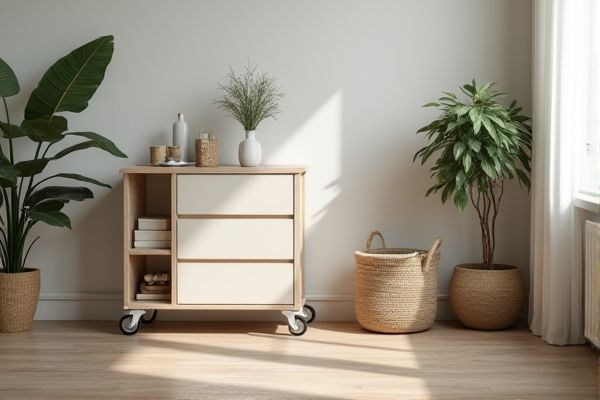
A rolling cart offers enhanced mobility and convenience for transporting items across various surfaces, while a stationary cart provides stable storage and organization in a fixed location. Discover which option best suits Your needs by exploring the detailed comparison in the rest of this article.
Table of Comparison
| Feature | Rolling Cart | Stationary Cart |
|---|---|---|
| Mobility | High - equipped with wheels for easy movement | Low - fixed in a single location without wheels |
| Use Case | Ideal for transporting items across different areas | Best for storing items in one place |
| Stability | Less stable due to mobility | More stable, suitable for heavy loads |
| Weight Capacity | Varies - often lower than stationary carts | Generally higher, designed for heavy-duty use |
| Storage Space | Usually limited to facilitate movement | Typically larger storage compartments |
| Price | Generally more expensive due to added mobility features | Often less costly |
| Maintenance | Requires wheel and frame maintenance | Minimal maintenance needed |
Introduction to Rolling and Stationary Carts
Rolling carts offer mobility and flexibility, making them ideal for transporting items across different locations with ease. Stationary carts provide stability and sturdiness, perfect for organizing tools or materials in a fixed workspace. Understanding the key differences helps you choose the right cart based on your specific storage and transportation needs.
Key Differences Between Rolling and Stationary Carts
Rolling carts feature wheels that enable easy mobility across various surfaces, making them ideal for dynamic work environments, while stationary carts lack wheels and provide a stable, fixed workspace. Rolling carts often include locking mechanisms on the wheels for stability when needed, contrasting with the inherently immobile design of stationary carts. The choice between rolling and stationary carts depends on the necessity for portability versus the requirement for a solid, unmovable support system.
Advantages of Rolling Carts
Rolling carts offer superior mobility, allowing you to easily transport tools, supplies, or equipment across various workspaces, enhancing workflow efficiency. Their flexibility supports dynamic environments such as workshops, kitchens, or offices by reducing the need to carry heavy items manually. The ergonomic design of many rolling carts minimizes strain and improves accessibility to stored items, making them a practical choice over stationary carts.
Benefits of Stationary Carts
Stationary carts provide enhanced stability and safety for heavy or sensitive equipment, minimizing the risk of accidents during use. Their fixed position ensures reliable organization and easy access to tools or materials, especially in environments with limited space. Maintenance requirements are lower compared to rolling carts, as stationary carts lack wheels that can wear out or become damaged.
Situational Suitability: When to Choose Each Cart
Rolling carts excel in environments requiring mobility, such as workshops, medical facilities, or kitchens where frequent repositioning boosts efficiency. Stationary carts are better suited for stable locations like offices or storage rooms where space optimization and easy access to fixed tools or supplies are crucial. Your choice should hinge on the need for flexibility versus permanence in your specific work or living space.
Space Efficiency and Storage Considerations
Rolling carts maximize space efficiency by offering mobility that allows easy repositioning in tight areas, optimizing floor space utilization. Stationary carts typically have a more compact footprint and can be integrated into fixed storage systems, enhancing stability but limiting flexible rearrangement. Storage considerations favor rolling carts when adaptability and access convenience are priorities, while stationary carts suit environments where consistent placement and durability are essential.
Mobility and Accessibility Features
Rolling carts offer enhanced mobility with wheels that allow you to easily transport items across different rooms or areas, making them ideal for dynamic workspaces and frequent rearrangement. Stationary carts, while lacking wheels, provide superior stability and are often equipped with accessibility features like adjustable shelves and ergonomic handles to improve user convenience. Choosing between the two depends on whether mobility or fixed accessibility is a priority for your specific needs.
Durability and Maintenance Comparison
Rolling carts typically feature robust wheels made from materials like polyurethane or rubber, enhancing mobility without compromising durability, while stationary carts often have reinforced frames designed to withstand heavy loads with minimal wear. Maintenance for rolling carts involves regular wheel inspections and lubrication to prevent jackknifing or uneven movement, whereas stationary carts require less frequent upkeep but demand periodic checks for rust or structural integrity, especially in industrial environments. Selecting between the two depends on usage frequency and work environment conditions, with rolling carts benefiting dynamic settings and stationary carts offering stability for long-term heavy-duty storage.
Cost Analysis: Rolling vs Stationary Carts
Rolling carts generally incur higher upfront costs due to added components like wheels and casters, which increase manufacturing complexity. Stationary carts typically offer lower maintenance expenses over time since they have fewer moving parts prone to wear and damage. Assessing total cost of ownership reveals rolling carts may lead to higher lifetime expenses despite mobility advantages, while stationary carts provide a cost-efficient solution for fixed workspace applications.
Final Verdict: Which Cart Is Right for You?
Choosing between a rolling cart and a stationary cart depends on your workspace flexibility and storage needs. Rolling carts offer mobility and versatility for dynamic environments, while stationary carts provide stability and higher load capacity for fixed setups. Assess your operational workflow and space constraints to determine the ideal cart type that enhances efficiency and meets your specific application requirements.
 homyna.com
homyna.com